It will not have gone unnoticed by those readers of the memorabilia on this web site that the arms of Sir Walter St John are displayed in a variety of forms. It might be helpful, therefore, to put down a few words of explanation as regards authenticity. Those who wish to take the matter further should read the appendix on Sinjun Heraldry in Frank Smallwood’s excellent ‘A History of Sir Walter St John’s School, Battersea 1700 – 1986’. Where there is no record of a grant of arms by the College of Arms to an institution, such as a school, as is the case with the Sir Walter St John’s Schools, Smallwood suggests that honour demands that the arms borne by the founder should be faithfully reproduced so that they would be clearly recognisable by Sir Walter himself. Fortunately a number of seventeenth century examples of the St John arms can be seen today in the truly remarkable east window of St Mary’s Church, Battersea. An authentic reproduction of Sir Walter’s arms appears on the cover of Smallwood’s history referred to above (figure 1).
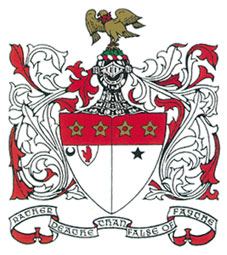
As can be seen the arms have a number of component elements – there is the shield and the devices there-on, the helm or helmet, the crest, the torse (the junction between the crest and the helmet), the mantling or drapery, and the motto.
The Shield
In heraldic terms the St John shield is ‘blazoned’ or described, as having an ‘argent field’ or background, which is depicted in either silver or white. The upper part of the shield (the ‘chief’) is a horizontal red (gules) band with two gold (or) five pointed stars or ‘mullets’. These represent spur-rowels and should have centre piercings. The simplicity of the shield is an indication of the antiquity of the family. Where a man of ‘coat-armour’ married a woman from a family of like standing, he was entitled to modify his arms by ‘impaling’ or adding his wife’s arms to his own. Since Sir Walter’s wife was Johanna St John her arms (also a shield argent with a chief gules with two mullets or, pierced) were ‘impaled’ with his. That is to say the shield is divided vertically with Sir Walter’s arms on the dexter side – the wearer’s right side of the shield, that is the spectator’s left – and his wife’s on the other, ‘sinister’ side.
Sir Walter was a baronet, a hereditary rank first created by James I in connection with the colonisation of Ulster. Baronets were entitled to display the badge of a baronet as an ‘augmentation’ to their arms. The badge comprised an ‘escutcheon’ or small shield displaying a left hand, severed cleanly at the wrist, portrayed vertically with the palm facing the spectator. The escutcheon should be argent and the hand, gules (figure 2). The legend of the hand dates from the Vikings. It had been decided that the first of two competing Viking chiefs to touch the soil of Ireland would be declared lord of the land. With yards to go in the race for possession one of the rivals cut off his left hand with his sword and threw it ashore, thereby securing the prize. However one should be careful not to confuse the escutcheon of a baronet with the ‘red hand’ of Ulster, which is a right hand with the palm facing the spectator, open and erect ‘couped at the wrist, gules’, as portrayed for example in the arms of the four provinces quartered as the arms of Ireland (figure 3). I have been unable to discover why the hand is displayed in two forms.

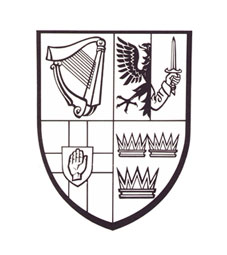
Sir Walter chose also to display a cadency mark, a black (sable) crescent, on the dexter side of the escutcheon to indicate that he was from the second branch of the family. This was not really necessary since he was then the only St John with the rank of a baronet and could have relied on the escutcheon to provide the necessary identification. However his wife was a younger daughter and therefore was obliged to display a sable mullet to distinguish her from her elder sister.
The Helmet
According to Smallwood the form of the helmet is a matter of artistic choice. For baronets and knights it should be depicted as being of steel. Peers had silver helmets and the sovereign gold. Before the Restoration the helmet was normally shown facing the dexter side but after 1660 the practice grew up of depicting the helmet full face, with the visor open.
The Crest
The St John crest is a gold falcon ‘rising’ from a green hillock (mount vert) with the wings ‘displayed’ ie extended on either side of the body, and ‘inverted’, ie pointing downwards. The bird is ‘belled’ having a gold bell tied to each leg with a leather thong or ‘jess’. It also wears a red coronet as a collar with three conventional strawberry leaves. These indicate that Sir Walter held a lesser rank than a duke, who could show five of the eight leaves to which he was entitled.
The Torse
This comprises a wreath of twisted fillets and represents the means of affixing the crest to the helmet, for example by leather thongs. The torse should show six alternations as it spans the top of the helmet and be coloured with the principal metal (argent) and colour (gules) in the shield, the metal leading on the dexter side
The Mantling or Drapery
This originates from the custom of draping fabric over the helmet to give some protection from the sun. The more battle hardened the warrior the greater the shredding of the mantling. There are no rules about how the drapery should be depicted but it should not be over elaborate and thereby detract from the arms. The colouring of the mantling usually is the principal metal and colour of the shield (argent and gules in our case), with the metal showing on the lining or inner side of the fabric.
The Motto
Smallwood suggests that the motto ‘Rather Deathe than False of Faythe’ is a Victorian invention. The St Johns used a number of family mottos, but this was not one of them. It first appeared stamped on school bibles in the mid 1850s and is carved in stone over the entrance of the Sinjuns school building which opened in 1859. But as Smallwood says its lack of antiquity should in no way detract from its suitability as the schools’ motto, given that it reflects Sir Walter’s faithfulness to the parliamentary cause in particularly turbulent times.
The Schools’ Use of the Arms
In 1875 when the Sir Walter St John’s School in Battersea High Street was separated into a middle and an upper school (with the latter becoming Battersea Grammar School) both schools used a coat of arms on their headed documents which was virtually the same, although both omitted the cadency marks – Sir Walter’s sable crescent and his wife’s sable mullet. The differences can be seen by comparing figures 4 and 5. It is interesting to speculate why this was, given that both schools were governed by the same trust. Presumably the schools wanted to establish their own separate identities.
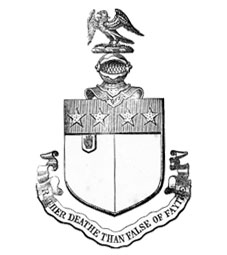
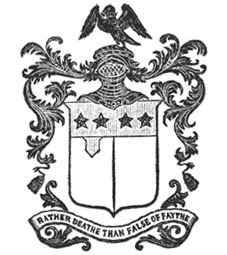
BGS kept the depiction of its arms unchanged until 1940 when the arms shown in figure 6 first appeared on the school prize distribution programme. The school magazine is silent on the reason why this was done and who did the design. There are two points of particular interest. Sir Walter’s cadency mark was placed below the escutcheon. It was understood in my day that this was done to distinguish the BGS arms from those of Sinjuns. The escutcheon correctly obtrudes slightly onto the chief, indicating that it was an added augmentation to the arms. But, unwittingly one hopes, the red hand of Ulster was used instead of the baronet’s badge. There were also too many strawberry leaves depicted in the coronet. Interestingly the old design was retained on the school magazine cover (figure 7) until 1948. In that year ‘The Old Grammarian’ magazine was first published and it naturally featured the then new coat of arms, which the Old Grammarians continue to use to this day.
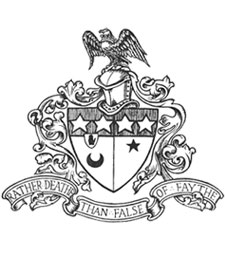

Another change to the BGS arms was made in 1959 (figure 8). Again no reasons for this are given in the magazine. The new design was by D Christie-Murray and D Escott who published a series of schools’ arms including ‘The Arms of Sir Walter St John’s School and Battersea Grammar School’ in handsome folders, with a detailed description, priced 2s. 6d. each. The correct baronets badge is used but the position of Sir Walter’s cadency mark is incorrect for Sinjuns in that the crescent should be in the next position of honour in the shield, ie on the dexter side of the escutcheon (see figure 1). Moreover the wings of the falcon are not inverted but are shown ‘elevated and addorsed’ ie the wings are spread and back to back, tips upwards. I could find no such depictions in St Mary’s. But as the creature is clearly a belled and jessed falcon ‘rising’ it would no doubt pass the Sir Walter St John recognition test.

As an aside, when in 1920, BGS introduced the white striped black blazer it seems to have been agreed that Sinjuns would use the St John shield as their breast pocket blazer badge and BGS the falcon rising, wings displayed and inverted. This latter was embroidered, dexter facing, in red with a gold coronet. This was used until the new arms were introduced in 1959 when Walter Langford adopted the elevated and addorsed version, in gold for the BGS Upper School and in red for the Lower School.
And finally as regards school colours, early school photographs show BGS boys wearing a tie with thick black and white horizontal stripes. After the Great War boys were wearing a red and white striped tie on a black ground. The school also had a Corps tie which had an additional yellow/brown stripe. After the Second World War house ties were introduced with an extra stripe in the relevant house colour. In 1924 the Old Grammarians’ Association promulgated its colours (which we still use) of old gold, white and red on a black ground, tinctures which Sir Walter St John would readily recognise as being taken from his arms.
M F Poffley
10 March 2002
